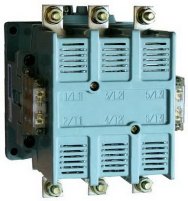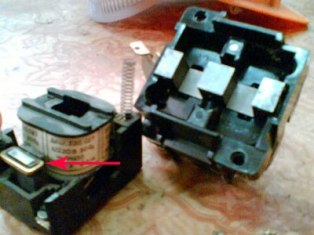Categories: Sharing experience, Electrician Secrets
Number of views: 55506
Comments on the article: 4
How to make a transformer from a magnetic starter
 If you have a magnetic starter with burned-out contacts or a broken case, but with a whole 220 Volt coil and a magnetic circuit, then you can make a transformer of not high power and any voltage with it yourself, but from it a charger.
If you have a magnetic starter with burned-out contacts or a broken case, but with a whole 220 Volt coil and a magnetic circuit, then you can make a transformer of not high power and any voltage with it yourself, but from it a charger.
Previously, when there was a malfunction of the magnetic starter, I simply dismantled it for parts or assembled one normal out of two three faulty magnetic starters. I was looking recently for a transformer to make a charger for AAA batteries (mini finger). Three of these batteries are in my flashlight. But recently I came across a magnetic starter with burned out contacts. I disassembled it, I look, there is a 220 Volt coil, there is a magnetic circuit, it remains only to wind the secondary winding and the transformer is ready.
On the coil of the magnetic starter it was written: "U = 220, W = 4400 turns PEV-2 Ø 0.14 mm." So, if 4400 is divided by 220, it turns out 20 turns per 1 Volt, since I need 4.5 Volts for the charger, the secondary winding should contain 20 * 4.5 = 90 turns.
If nothing is written on the coil, we act differently, we wind 20 turns of wire over the coil and assemble the transformer with our own hands.
We turn the transformer into a 220 volt network and measure the voltage at our 20 turns, then divide 20 by the measured voltage, we get the number of turns that need to be wound to get 1 Volt, we multiply by the required voltage, we get the number of turns of the secondary winding that need to be wound - mathematics 1 class.
By the way, you can take a coil and 380 Volts. The secondary winding for it is calculated above as described.
Having determined the required number of turns for the secondary winding, wrap it. The number of turns should not be much larger than calculated, since on the one hand the supply voltage is not stable, on the other hand, a voltage drop will occur under load.
The secondary winding is wound with a wire of a larger cross section than that of the primary winding, moreover, the lower the voltage, the larger the cross section. The winding wire can be taken from a coil of a magnetic starter or relay for a voltage of 24 Volts or a car relay for 12 Volts with burned-out contacts, or any other with enamel insulation.
The secondary winding of our transformer is wound so that the coil can enter the magnetic circuit, so you need to choose the right section of the wire and the number of turns. The wound secondary winding must be insulated with varnish or other material.
Please note that there is a short-circuited coil of copper or brass on the magnetic circuit of the magnetic starter (the arrow shows in the picture on it) in our transformer it is not needed. On my starter, two of them on one side and the other are made of brass, I removed them with a screwdriver.
In principle, everything is ready, you can assemble the transformer. The best thing is to connect the two parts of the magnetic circuit with epoxy glue. To do this, we clean the ends of the magnetic cores with a solvent, apply glue, connect them, of course we do not forget to install the coil, and clamp in a vice.
Homemade transformer from a magnetic starter
Here is the transformer from the magnetic starter ready. But before you assemble the transformer thoroughly, you should collect it temporarily and check its parameters voltage, current, assemble the circuit of the device and check its performance.
The charger is simple. Added to the transformer diode bridge and connected batteries to it through a makeshift wire resistor. The wire resistor made of nichrome wire, choosing its length according to the charging current. Current measured with a multimeterachieving 10% of battery capacity.The charger was placed in the body of the magnetic starter, removing all unnecessary from it.
Read also:The device and principles of operation of the magnetic starter
See also at bgv.electricianexp.com
:

